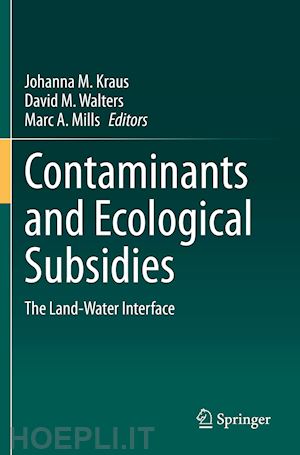
Questo prodotto usufruisce delle SPEDIZIONI GRATIS
selezionando l'opzione Corriere Veloce in fase di ordine.
Pagabile anche con Carta della cultura giovani e del merito, 18App Bonus Cultura e Carta del Docente
David M. Walters, Ph.D. is a Research Ecologist with the U.S. Geological Survey (USGS) Columbia Environmental Research Center. His research focuses on the effects of human stressors on the form, function, and structure of aquatic and riparian ecosystems with an emphasis on food web dynamics and contaminants. He began his career at the U.S. Environmental Protection Agency National Exposure Research Laboratory in 2002 before joining the USGS in 2008. His publications have addressed the impacts of contaminants, land use and climate change, invasive species, and hydrologic alteration on aquatic and riparian organisms and are geared toward furthering the conservation and restoration of these valued ecosystems. He received an M.S. and Ph.D. from the Odum School of Ecology at the University of Georgia.
Marc A. Mills, Ph.D. is an Environmental Engineer at the U.S. EPA’s Office of Research and Development and is a principal investigator for projects characterizing the occurrence, transport, and fate of contaminants of emerging concern (CECs) and legacy contaminants in the environment and the management of contaminated sediments. Dr. Mills leads research to identify sources of contaminants to aquatic systems and tracing their movement through the environment and food webs. He also leads the development of analytical methods for CECs (e.g. PFAS, EDCs, PPCPs) and stable isotope chemistry for environmental samples in water, wastewater, solids, and tissues at the Center for Environmental Solutions and Emergency Response (CESER) for U.S. EPA. These methods are used to characterize potential sources of CECs and legacy contaminants, their management in water, wastewater treatment, water bodies, and new technology development. Dr. Mills has a B.S. in Civil/Environmental Engineering from Texas A&M University and a M.S. and Ph.D. from the Texas A&M University.











Il sito utilizza cookie ed altri strumenti di tracciamento che raccolgono informazioni dal dispositivo dell’utente. Oltre ai cookie tecnici ed analitici aggregati, strettamente necessari per il funzionamento di questo sito web, previo consenso dell’utente possono essere installati cookie di profilazione e marketing e cookie dei social media. Cliccando su “Accetto tutti i cookie” saranno attivate tutte le categorie di cookie. Per accettare solo deterninate categorie di cookie, cliccare invece su “Impostazioni cookie”. Chiudendo il banner o continuando a navigare saranno installati solo cookie tecnici. Per maggiori dettagli, consultare la Cookie Policy.